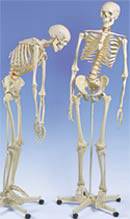Home » Diagnostic Supplies Products Equipment » Anatomical Models » Anatomical Models
Anatomical Models
Mini Mounted Skeleton On A Base
Retail Price: $463.40
Your Price: $325.53
 Unit: single
Unit: single

Mini Skeleton with Muscles Mounted on Base
Retail Price: $628.02
Your Price: $481.33
 Unit: single
Unit: single
Human Anatomy Models in Teaching
You probably know the old saying that a picture is worth a thousand words. If a flat, lifeless picture is worth a thousand words then a model must be worth millions. Human anatomy models are a terrific addition to any biology class for all grade levels, from early elementary school up to formal medical classes in colleges and universities. Choosing the right match in human anatomy models for your teaching requirements is essential, since you need them to be comprehensive, yet also practical and within your budget.
Students in elementary through high school grades will find both entire body as well as specific organ human anatomy models extremely helpful in being able to clearly visualize the parts of the body. Models that are three dimensional in design will help the children in understanding the specific shape and size of the organ or body structure in much more realistic terms than just looking at a movie, computer program or through studying a science textbook.
When choosing human anatomy models for children in elementary and middle school staying with the basic models is highly recommended. Too many details can be confusing; however, you do need the model to be accurate and not overly simplified. Some models are sold specifically for use with younger students. They have been designed to be durable, practical and accurate without providing more detail than necessary. Oversized models of some of the body organs such as the eyes, ears, nose and brain are a wonderful way to allow students to clearly see the smallest structures and components.
Models for younger children may or may not have removable parts or features. Keep in mind that removable parts can be lost and these types of models may need supervision in use to prevent this problem. Usually children by the middle to high school are responsible enough to properly use the basic models and replace the large sections or pieces that are removable. High school and college human anatomy models should be made of durable high quality plastic to avoid damage with regular use. Look for models that are more detailed and more anatomically correct as opposed to simple and basic for this group of learners. Color coding, back displays with written details and information as well as color coding and charts that accompany the model are perfect for self and group study.
Human anatomy models can be very lifelike in their appearance or they can be designed to highlight specific structures with vibrant colors. Both are great options for older students, since they can allow much more detail to be included in the model. Removable small parts or unique types of cross section models are perfect for studying parts of the circulatory, digestive, reproductive and respiratory systems.
For more advanced students in medical or pre-med classes, very detailed and very accurate human anatomy models are essential. Students that have access to these types of models can become comfortable in identifying and working with accurate representations body parts, as well as diseases. Working with human anatomy models in laboratory and classroom activities provides a level of confidence and understand that isn't possible without the model.
MSEC remains dedicated to providing the very best and the very latest in medical supplies and equipment. We never cease to be on the lookout for the latest innovation that will benefit both our many clients and the patients they dedicate their lives to caring for. If you have any difficulty finding your choices in our vast inventory, call our customer service at 1-877-706-4480 to speed up your order or to make a special request. We are always happy to help you.
Learn More About Anatomical Skeleton Models
- Anatomical Model Options For Teaching And Discussion
- The Ideal Human Anatomy Model
- Anatomical Skull Models For Teaching And Study
- Anatomical Skeleton Models To Enhance Teaching And Understanding
- Considerations For Brain Anatomy Models
- Ideas For Using Digestive System Models With Patients Or Students
- Anatomical Anthropological Skulls
- Human Eye Models For Teaching Patients Or Students
- How Anatomical Pelvis Models Can Help Your Patients
- Anatomical Human Heart Models Clear Up the Confusion
- Lungs Anatomy Models Make Teaching A Breath Of Fresh Air
- Get A Grip On The Body With A Human Anatomy Muscle Model
- Human Torso Anatomy Models Make Learning Simple
- Back Your Discussions Up With A Vertebrae Anatomy Model
- Key Factors in Selecting Human Anatomical Models
- Using a Human Elbow Joint Model in Your Medical Practice
- How Shoulder Joint Models are Created
- Options for Knee Joint Models
- The Benefits of Having 3D Wrist Models in Clinical Settings
- Choosing The Best 3D Anatomy Models
- Patient Consultations Using a Hip Joint Model
- Helping Patients Through The Use Of A Kidney Model
- 3D Human Eye Model Options
- Using Larynx Models to Discuss Diseases of the Throat
- Using an Artery Model for Medical Consultations
- 3D Human Lung Model Styles and Options
- Looking at a 3D Human Brain Model
- Buying a 3D Anatomical Foot Model
- Addressing Thyroid Conditions Using a Thyroid Model
- Using a Colon Model to Understand the Colon
- Classroom Activities Using A Prostate Model
- Using a 3D Anatomy Ear Model in the Science Classroom
- 3D Anatomical Breast Model Options for Examination Rooms
- The 3D Teeth Model in Action
- Choosing the Best 3D Human Heart Model for the Job
- A 3D Finger Model Points the Way to Understanding Hand Anatomy















